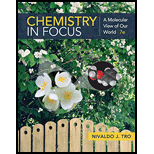
Interpretation:
The true statement from the given statements about a nonpolar molecule having polar bonds is to be determined.
Concept introduction:
The bond formed between atoms with different electronegativities is a polar bond.
In the nonpolar bonds, the electrons are equally shared between the atoms.
In the polar bonds, the electrons are shared unequally between the atoms, which creates a dipole moment.
To classify the molecule as polar or nonpolar, the molecular geometry of the molecule is considered with the help of the Lewis structure and the VSPER theory. If the molecule has a dipole moment, the molecule is termed as a polar molecule. The symmetrical molecules are nonpolar because the dipole moments cancel each other.
If a molecule has polar bonds, it may or may not be polar depending on the symmetry of the molecule.
Want to see the full answer?
Check out a sample textbook solution
Chapter 5 Solutions
Chemistry In Focus
- For the first ionization energy for an N2 molecule, what molecular orbital is the electron removed from?arrow_forwardWhy is the geometric structure of a molecule important, especially for biological molecules?arrow_forward(a) dispersion force Dispersion forces are (Very weak),(Very strong) electrostatic attractions that occur due to the random electronic motion within all substances,(excluding),(including) those that are nonpolar. When the electrons within a molecule or atom are distributed asymmetrically about the nucleus, that molecule or atom will adopt a (temporary),(permanent), (induced),(instantaneous) dipole. The presence of this dipole can then distort the electrons of a neighboring atom or molecule, producing an (induced),(instantaneous) dipole. These two rapidly fluctuating dipoles thus result in a brief electrostatic (attraction),(Repulsion) between the two species. These forces are stronger in (Larger and heavier),(Smaller and lighter) atoms and molecules. For example, dispersion forces between (Fluorine),(iodine) molecules will be stronger than dispersion forces between (Fluorine),(iodine) molecules. (b) dipole-dipole attraction A dipole-dipole force is the electrostatic attraction…arrow_forward
- Are CH3+ and CH3 ̄ symmetrical or unsymmetrical molecules? Explain your reasoning.arrow_forwardHow does decreasing the total energy of the system affect the stability of the pair of atoms in the system? Does this decrease in total energy make them more or less likely to stick together (AKA form a stable interaction)? A:More likely to stick together B:Less likely to stick togetherarrow_forwardWhich is the correct electron configuration for B2 + according to the molecular orbital theory? A. σ1s2 σ * 1s2 σ2s2 σ * 2s2 σ2pz1 B. σ1s2 σ * 1s2 σ2s2 σ * 2s2 π2px1π2py1 C. σ1s2 σ * 1s2 σ2s2 σ * 2s2 π2px1 D. σ1s2 σ * 1s2 σ2s2 σ * 2s2 σ2pz2arrow_forward
- Compare the strength of the bonds that holds the atom in a molecule together with the forces the exist between different moleculesarrow_forward1. How do shape and symmetry influence the polarity of a molecule? cite specific examples. 2. Classify each covalent molecule as polar or nonpolar.arrow_forwardWhat is an "electronic geometry"?arrow_forward
- VSEPR theory can be used to predict the shapes that simple molecules form. First, explain the concepts used in VSEPR theory to predict what shape a molecule with form. Then, using VSEPR theory, state the shapes that each of the following molecules will form.arrow_forwardHow do I know if a molecule is polar or nonpolar with just looking at it?arrow_forwardWhat have I done wrong here? And what is the bond angle?arrow_forward

 World of Chemistry, 3rd editionChemistryISBN:9781133109655Author:Steven S. Zumdahl, Susan L. Zumdahl, Donald J. DeCostePublisher:Brooks / Cole / Cengage LearningChemistry: Matter and ChangeChemistryISBN:9780078746376Author:Dinah Zike, Laurel Dingrando, Nicholas Hainen, Cheryl WistromPublisher:Glencoe/McGraw-Hill School Pub Co
World of Chemistry, 3rd editionChemistryISBN:9781133109655Author:Steven S. Zumdahl, Susan L. Zumdahl, Donald J. DeCostePublisher:Brooks / Cole / Cengage LearningChemistry: Matter and ChangeChemistryISBN:9780078746376Author:Dinah Zike, Laurel Dingrando, Nicholas Hainen, Cheryl WistromPublisher:Glencoe/McGraw-Hill School Pub Co Introductory Chemistry: A FoundationChemistryISBN:9781337399425Author:Steven S. Zumdahl, Donald J. DeCostePublisher:Cengage Learning
Introductory Chemistry: A FoundationChemistryISBN:9781337399425Author:Steven S. Zumdahl, Donald J. DeCostePublisher:Cengage Learning Chemistry by OpenStax (2015-05-04)ChemistryISBN:9781938168390Author:Klaus Theopold, Richard H Langley, Paul Flowers, William R. Robinson, Mark BlaserPublisher:OpenStax
Chemistry by OpenStax (2015-05-04)ChemistryISBN:9781938168390Author:Klaus Theopold, Richard H Langley, Paul Flowers, William R. Robinson, Mark BlaserPublisher:OpenStax





